Lane was relatively new to the Hudson's Bay Company, arriving at York Factory in June, 1838, and transferring down to Red River by September where he stayed as an accountant until 1845, some 7 years. Sir George Simpson sent him next to Fort Vancouver, promising Lane he could return to Red River in 1846. Why?
These are the facts. But I'm having a harder time finding out the story behind these surface facts.
Lane did return to Red River in 1846 to marry Mary (Marie) McDermot, daughter of prominent trader Andrew McDermot and his wife Sara McNab, a Métis with whom he had 17 children.
 |
| Annie McDermot Source: Destination Winnipeg Click for larger view. |
I did find some lovely stuff about their wedding for Mary's mother Sara loved to dance. Métis weddings could last several days of feasting and dancing. Paul Kane should have painted this (I'm imagining a Peter Bruegel type scene).
I did find a photograph of Annie McDermot (b. 1830), Mary's sister, who may give a sense of what Mary looked like as a young woman.
 |
| Portrait of a Half-breed Cree Girl Source: Kane's Wanderings of a Young Artist Click for larger view. |
Cunnewa-bum (whose name means 'She That Looks at Stars') holds a fan. Her innocent gaze, some critics say, suggests flirtation, but I don't see that, but her name is lost when retitled as "Portrait of a Half-breed Cree Girl" in Paul Kane's Wanderings of a Young Artist.
In my story, Rivers of Stone, would Paul Kane have recognized Catriona as a woman in the grubby boy who traveled with him, given his romantic vision of women?
Richard Lane's story ends sadly with alcoholism and suicide some 30 years after the death of Mary in 1851.
After probably two many hours of reading and research this morning, I found a sumptuous new book on Paul Kane by Arlene Gehmacher, Paul Kane: His Life and Works (available as a free PDF download).
Now, back to work on revising and editing Rivers of Stone. Tomorrow's entry for that April A to Z Blogging Challenge will be "M" for Mount St Helens. Now what would a volcanic eruption have to do with Rivers of Stone?
Check out what others have posted for A to Z HERE.

No comments:
Post a Comment